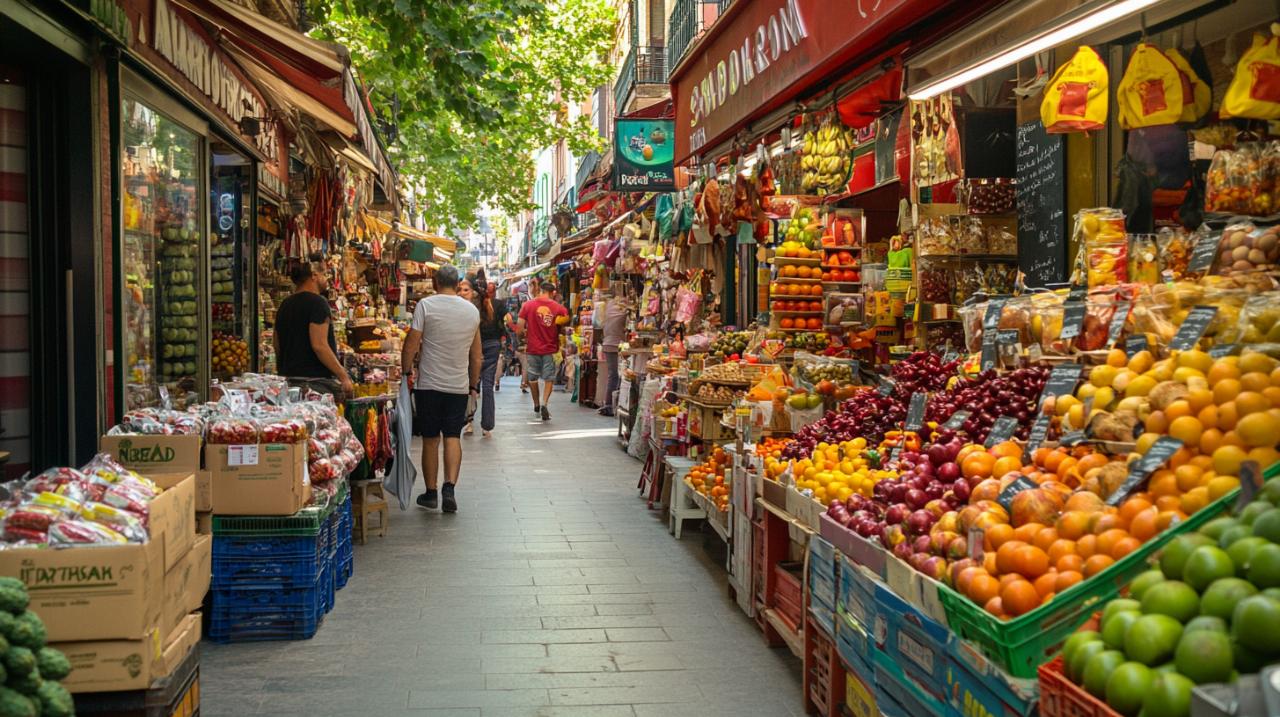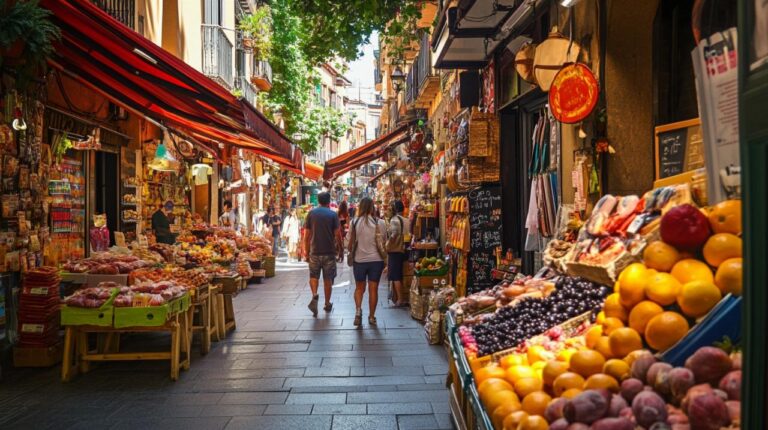Exploring the vibrant cities of Madrid, Barcelona, and Seville offers more than just stunning architecture and rich history. These destinations are treasure troves for shoppers seeking everything from high-end fashion to artisanal crafts, and with a bit of savvy planning, you can make your euros stretch further than you might think. Whether you’re hunting for traditional Spanish leather goods, sampling gourmet delicacies, or simply looking for unique souvenirs, understanding the local shopping culture and timing your visits wisely can transform your experience from expensive to economical. The key lies in knowing where to look, when to go, and how to engage with vendors in a way that respects local customs whilst securing the best possible prices.
Mastering market shopping and street bargains
Spain’s street markets are a cornerstone of the shopping experience, offering a lively atmosphere and an array of goods that range from vintage clothing to handcrafted pottery. In Madrid, the famous El Rastro flea market draws locals and visitors alike every Sunday morning, where the art of negotiation is not just accepted but expected. This sprawling market stretches through the Lavapiés and Embajadores neighbourhoods, presenting an opportunity to find everything from antique trinkets to modern fashion at prices that can be significantly lower than those in traditional shops. Barcelona’s markets, such as those in the Gothic Quarter, similarly provide a chance to discover unique items whilst soaking in the authentic ambience of the city. When you venture into these bustling spaces, remember that the experience is as much about the cultural exchange as it is about the purchase itself.
Navigating Local Markets for the Best Deals
To truly maximise your savings, it’s essential to approach market shopping with a strategy. Arriving early in the morning often means you’ll have first pick of the freshest produce and most interesting items, whilst visiting later in the day, particularly as vendors are preparing to pack up, can lead to impromptu discounts as sellers prefer to move stock rather than transport it home. Markets selling produce and tapas in the evenings frequently offer discounted prices, making them ideal for budget-conscious travellers looking to enjoy authentic Spanish flavours without the restaurant markup. In cities like Seville, the smaller neighbourhood markets provide not only competitive pricing but also a more intimate glimpse into daily life, far removed from the tourist-heavy zones. Walking through these areas, you’ll notice that prices drop noticeably just a street or two away from the main thoroughfares, where the quality remains high but the markup for visitors disappears. For those interested in gourmet products, markets are the place to sample and purchase Iberian ham, regional cheeses like Manchego or Cabrales, local olive oil, and traditional sweets at prices that reflect their true value rather than inflated tourist rates.
The Art of Polite Haggling in Spanish Markets
Whilst haggling is a common practice in markets such as El Rastro, it’s important to approach it with courtesy and respect. Spanish vendors appreciate a friendly demeanour and a genuine interest in their wares, so starting a conversation about the item’s origin or craftsmanship can often lead to a more favourable price. The key is to be polite and reasonable, understanding that the seller has set their prices with their livelihood in mind. A gentle enquiry about whether there’s any flexibility on the price, especially if you’re purchasing multiple items, is far more likely to succeed than aggressive bargaining. Many vendors are happy to offer a modest discount to a customer who shows appreciation for their goods and engages respectfully. It’s worth noting that in more formal retail environments, such as the boutiques in Barrio de Salamanca or the shops along Gran Vía, prices are fixed and haggling is not expected. However, even in these settings, asking politely if there are any ongoing promotions or loyalty discounts can occasionally yield unexpected savings. For those seeking recommendations on where to find the best deals, resources such as the zonaprecio blog can offer valuable insights into current offers and promotions across various retailers, helping you plan your shopping excursions with greater precision.
Timing your shopping for maximum savings

Understanding when to shop can be just as important as knowing where to go. Spain’s retail calendar includes specific periods when sales are most advantageous, and aligning your visit with these times can lead to substantial savings. Beyond the traditional sales seasons, being mindful of local customs around opening hours and meal times can also help you navigate the shopping landscape more effectively, ensuring you’re in the right place at the right time to snag the best bargains.
Taking advantage of off-season sales
Travelling to Madrid, Barcelona, or Seville during off-peak months such as May, June, or September not only means fewer crowds and more pleasant weather but also better prices on accommodation, dining, and shopping. During these periods, many retailers, particularly those in tourist-heavy districts, offer discounts to attract customers during slower times. Major shopping events, including end-of-season sales in winter and summer, see significant reductions on fashion items from Spanish designers and international brands alike. If you’re flexible with your travel dates, planning your trip to coincide with these sales can result in savings of up to sixty percent on clothing, accessories, and home goods. Additionally, many large shopping centres and department stores extend their hours during sale periods and remain open on Sundays, providing ample opportunity to browse and compare prices. For those interested in gourmet products, visiting local producers and artisanal workshops during quieter months often allows for more personalised experiences, including tastings and the chance to purchase directly from the source at prices lower than those in tourist shops. Markets and traditional shops in neighbourhoods such as Chueca, Malasaña, and Lavapiés offer a mix of modern and vintage items year-round, but visiting during less busy times means you can take your time exploring without the pressure of crowds.
Finding value beyond the tourist hotspots
Venturing away from the main tourist areas can dramatically reduce your costs whilst enriching your experience of Spanish culture. In Madrid, exploring districts such as Chamberí or Conde Duque reveals a wealth of artisanal workshops, gourmet food shops, and independent boutiques where prices reflect local rather than tourist demand. Similarly, in Barcelona, moving beyond the Ramblas to neighbourhoods like Gràcia or Sant Antoni offers access to markets, traditional shops, and family-run businesses that prioritise quality and authenticity over volume and profit margins. Seville’s smaller towns and surrounding areas, including rural villages in Andalusia, provide opportunities to purchase handcrafted pottery, leather goods, and wickerwork directly from artisans at a fraction of the cost you’d pay in city-centre tourist shops. When it comes to dining, taking advantage of the Menu del Día, a set lunch menu offered by many restaurants, is a tried-and-true method of enjoying a hearty three-course meal for around eight to ten euros, far less than ordering à la carte in the evening. Bakeries and cafes also serve breakfasts at prices significantly lower than those charged by restaurants in tourist zones, making them ideal for a quick and economical start to your day. For longer stays, consider grocery shopping at local supermarkets and preparing picnics to enjoy in one of Spain’s many beautiful parks or natural attractions, which are free to access and offer a peaceful respite from the hustle and bustle of city shopping. Transport savings can be achieved by using regional bus networks such as ALSA, which offer cheaper fares than trains, or by renting bikes and walking, both of which are not only economical but also allow you to discover hidden gems along the way. Discount cards like the Madrid Card or Barcelona Card provide deals on museums, attractions, and transport, further stretching your budget whilst ensuring you don’t miss out on the cultural highlights of your visit.





